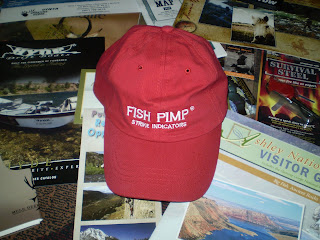
I kept using the same yellow streamer with the green rubber legs but after a half hour with no strikes I switched to a black, rabbit fur streamer. I am always experimenting with different flies and trying to find some new ones in which to gain confidence. I placed another small split shot above the streamer so I could probe the depths of the deeper holes. Even though I had caught the last two large trout in the shallow riffles, I know there has got to be large fish in the deep holes in this section of the river.
By now it is time to start working my way back upstream. The next stretch has what looks like a nice deep section next to a long section of flat shallow water. I cast up above where the best spot to target would be so the fly will have time to sink into the deeper portion of the pool. Right as it passes the deepest part, the fly suddenly stops, but doesn’t move. I can feel resistance on the line but can’t tell if it is a snag or a big fish. Suddenly it moves but stays deep. It never makes a long run but is really fighting hard to stay in the deep water. I let it fight for a few minutes to tire it out before trying to bring it to the net. Finally I pull it close enough to tell it is a big brown that is foul hooked on its dorsal fin. Fish that are foul hooked are real tough to land. I am very careful to bring him closer very smoothly. Any sudden jerks and the hook may come out. I scoop the net underneath him just as the hook comes loose. Luckily I had the net under him just in time. He is not a calm fish. He is fighting even though he is loose from the hook and is in the net. I set the net with him in it on the shore. As I go to take a picture, he jumps completely into the air. What an amazing fighter. Doing all this jumping around has covered him in dead grass so I put him back into the net and place the net in the water. This washes him off so I can get a decent picture. He measures 19 inches. Not as big as the last fish but still longer than the net, excluding the handle. What an amazing evening. Three fish 17 inches and longer.
While changing out of my waders I talked to the sheep rancher. He says “great weather, I guess any day fishing is better than working.” I explained to him that I had put in a full day of work and that I just stopped by the river on the way home. I told him the river was a little higher than last week and slightly off color. He told me there is a small stream that flows through town that is high and dumping a lot of mud into the river. I guess this is to be expected with the warmer spring weather. Hopefully I can get in another day or two of fabulous fishing before the real runoff starts.
























